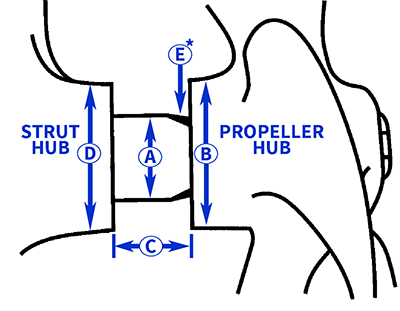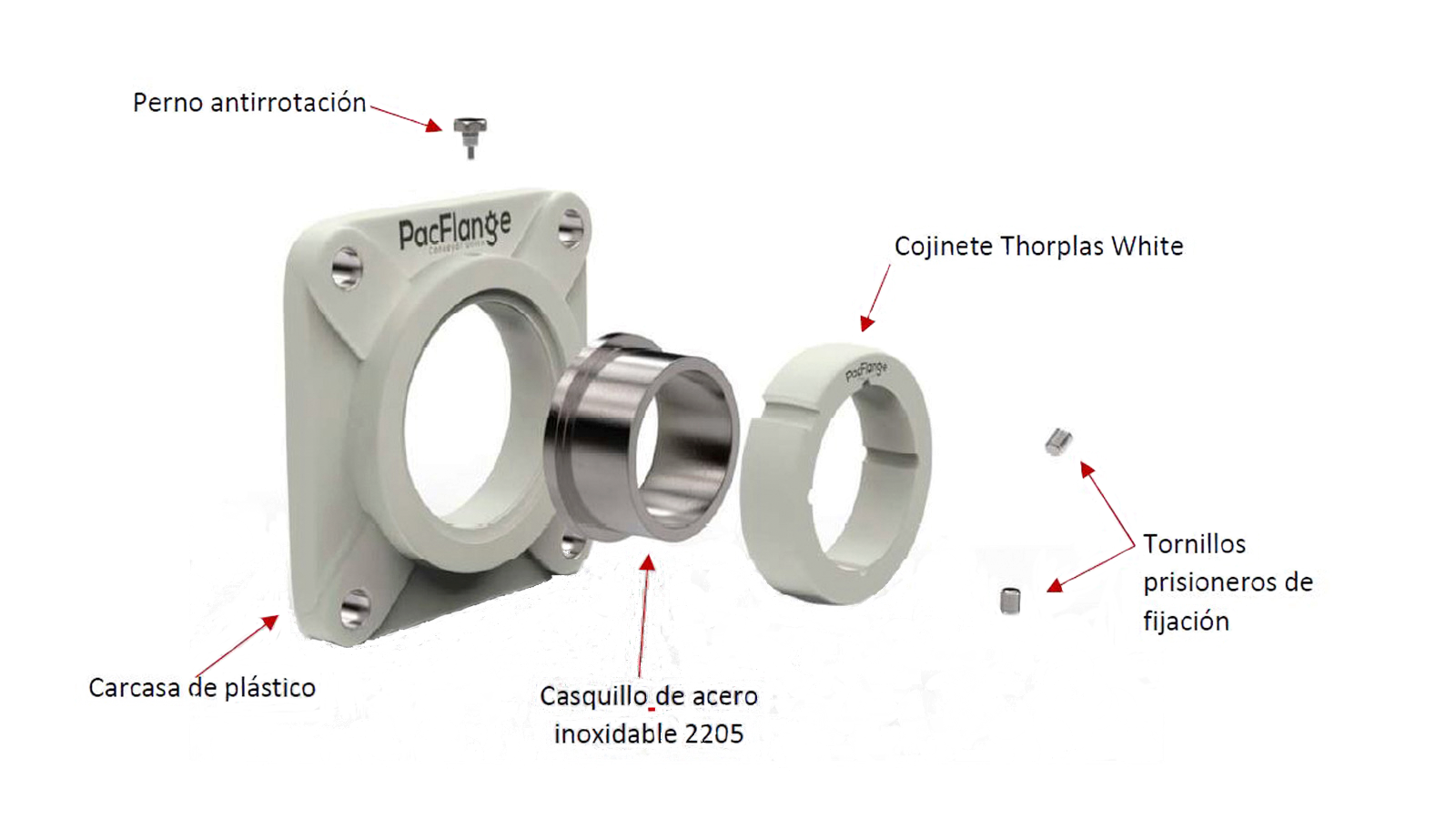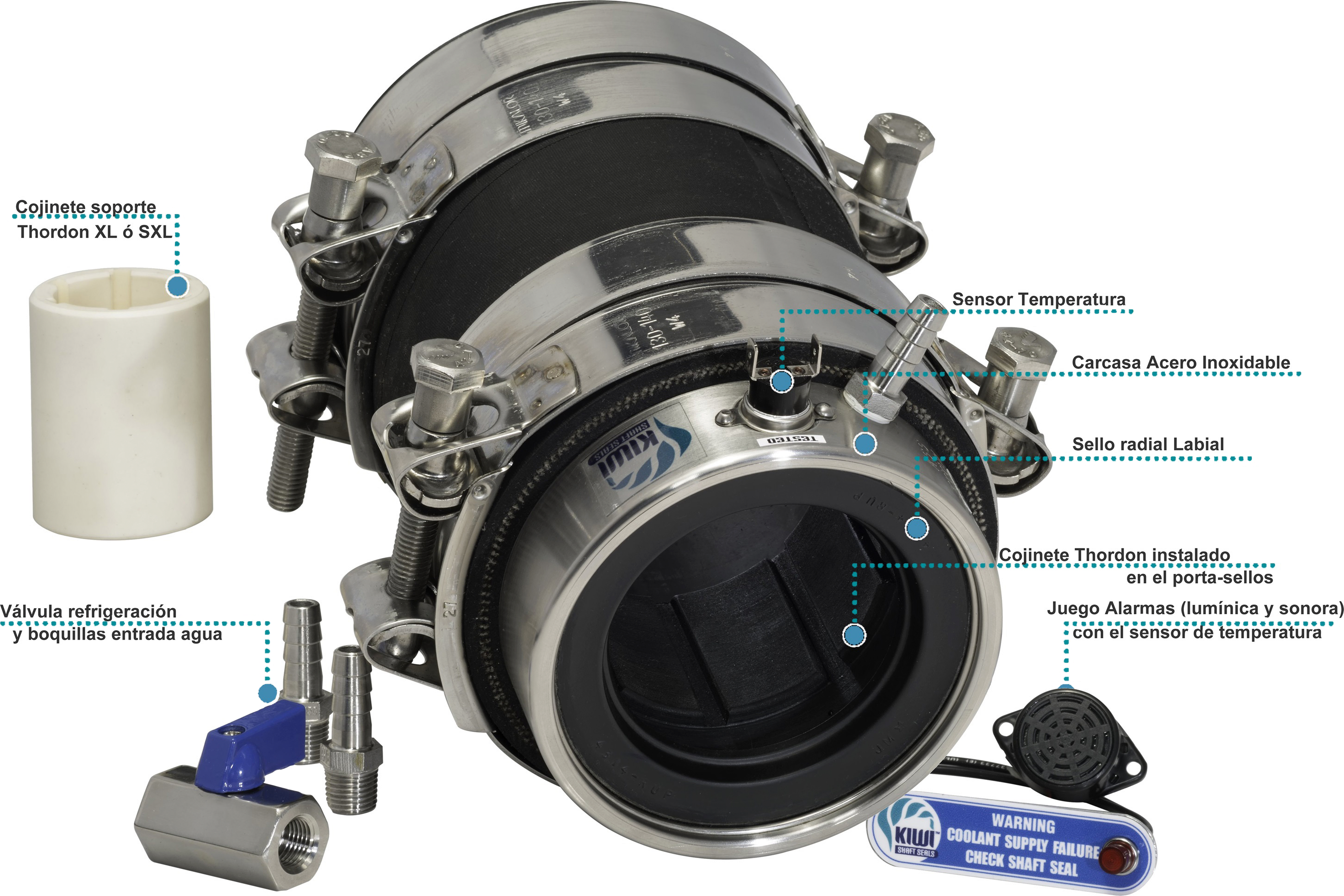The Thordon polymer is an strongelastomeric material made of thermosetting resins which are polymers with three-dimensionally interwoven structures. Thordon is a very hard and resistant synthetic polymer alloy with performance characteristics which are superior to other materials used for both metallic and non-metallic bearings and bushings.
Compared to other materials, Thordon works particularly well in applications where the material is exposed to or submerged in water, especially in extremely dirty conditions, and where shock forces are an important factor.
It offers the best combination of the main property of plastics (strength/hardness) and the main property of rubber (flexibility/elasticity). It is one of the materials with the highest resistance to abrasion and wear.
Thordon is a non-corrosive material and is also resistant to oil, grease, water and most chemical products. Nor is it affected by the lubricants commonly used in bushings and bearings. It is not attacked by mild acids or mild salts (pH 2-7) or other chemical environments that are harmful to metal bearings (a general chemical resistance guide is available).
The L/D ratio for a typical industrial bearing varies from 1:1 to 1.5:1. This is the optimal ratio that allows for simple alignment and assembly.
In marine applications, in stern tubes for drive shafts with water-lubricated bearings, the L/D ratio has historically been 4:1 to reduce bearing pressure – for example, to 0.25 MPa. However, considering the loading of the propeller, the pressure distribution tends to be higher near the propeller and almost zero at the other end. In operation, this high L/D ratio tends to create more friction or to drag the shaft. This is because the front part of the bearing is not supporting the shaft and creates unnecessary turbulence in the water. There may even be contact between axle and bearing in the upper part (at 12 o’clock) of the front part of the bearing.
We are certified by all approval bodies to work with the L/D ratio of 2:1. This ratio was tested with Thordon under the same conditions as the 4:1 ratio and was found to generate less frictional force. As a consequence of these tests together with the encouragement of the approval bodies, the Thordon COMPAC bearing system was developed.
In most applications, where the bearing load is uniform, a higher L/D ratio will reduce pressure and improve bearing life. Alignment becomes more difficult, but if the pressure is too high, an increase in the L/D ratio may be necessary. For bearings for the COMPAC tail shaft the L/D ratio must not be greater than 3:1. This limit is set to avoid problems with the distribution of cooling water to bearings that are too long turning at relatively high speeds.
The materials normally used in the shafts provide a suitable contact surface for working with Thordon bearings. If corrosion is not a problem, carbon steel is commonly used, but if corrosion is a problem then you should choose materials that are not affected by corrosion such as bronzes, stainless steel, duplex stainless steel, etc. (nickel, aluminium and titanium are not usually recommended since experience has shown that they can lead to high wear rates).
Stainless steel is also frequently used in shaft sleeves to work with Thordon bearings. If there is a lot of abrasion, softer stainless steels such as AISI 304 are not recommended. Similarly, the softer types of Aquamet shaft system are not recommended if the shaft is exposed to significant abrasion. The hardest grades of stainless steel or Inconel 625 are preferred by Thordon. Instead of the sleeve, some manufacturers use stainless steels or Inconel 625 spirally welded over the full length of the shaft or only in the area where the bearings work. In any application where the bearing is exposed to very abrasive conditions, the optimal combination of contact surfaces is the hardest possible shaft together with the softest bearing material that will support the load.
For very aggressive abrasives the solution recommended by Thordon is the Thordon Composite bearing with a surface treatment of the shaft or shaft sleeve with a minimum hardness of Rockwell C 40. In general, softer bearing materials such as Thordon tend to wear the shaft less and also suffer less combined wear between the shaft and the bearing. The hardest shaft and the softest bearing is the ideal combination for the minimum combined wear in severe abrasive environments. If the shaft is changed for one with a softer material or if the bearing is changed to one with a harder material, the combined wear will increase. If the environment contains less abrasives, then the importance of having the hardest shaft material and the softest bearing material decreases. In this case, other requirements such as the lower coefficient of friction take priority for the selection of the Thordon grade.
In a clean environment with lubrication (which only happens in theory) any combination would be valid. However, the principle of a bearing which is softer than the shaft surface is always a good guide. Making two surfaces of the same material work in contact with each other is very dangerous and should always be avoided. Do not operate with a Thordon bearing in contact with a shaft sleeve made of Thordon.
The surface finish of the shaft must be sufficiently polished to limit the initial contact wear. It has been found that having a more polished shaft reduces the heat generated by friction and increases the PVT limits. Thordon works satisfactorily against a machined shaft surface with a normal surface finish. For the best operation, a final surface finish, Ra, of 0.4 to 0.8 micrometres (16 to 32 microinches) is recommended. Surface finishes up to an Ra of 1.6 micrometres (63 microinches) will work satisfactorily.
The Thordon XL, SXL, COMPAC and Composite bearings are normally mounted using an interference-fit installation. Installation is quick and easy, especially when the assembly is carried out using shrink-fitting. Thordon can be glued to the housing, using a Thordon approved adhesive. This is appropriate in the following circumstances:
The final dimensions of a Thordon bearing will depend on the method to be used in its installation. The selection of the best installation method is extremely important and will depend on the requirements of the application. An interference-fit installation is sufficient to prevent rotation of the bearing under normal operating conditions, but a support at the front and a retaining ring screwed at the back is recommended to prevent axial movement of the bearing. The retaining rings must be of an appropriate size and have an internal diameter approximately 3 mm greater than the diameter of the grooves or 3 mm greater than the internal diameter of the bearing if it does not have grooves. The supports and retaining rings are not mandatory when a bearing is mounted by gluing to the housing but they are recommended in critical applications as a safety measure. In cases where the orientation of the bearing is critical, such as when the bearing is not concentric or for the COMPAC bearings, it is recommended to fit an anti-rotation device.
Shrink-fit assembly is the easiest way to install a Thordon bearing. Thordon material contracts significantly when cooled due to its high coefficient of thermal contraction/expansion, facilitating installation without the need for additional equipment. Liquid nitrogen is the best cooling agent, but dry ice can also be used in most installations if liquid nitrogen is not available.
Liquid nitrogen should only be used in a well-sealed container to avoid liquid losses. The bearing must be completely submerged or covered with liquid nitrogen. When no more vapour is produced by the liquid nitrogen, due to the boiling process, the bearing will have reached a temperature of -196°C and can now be easily installed (the process takes approximately 5 to 30 minutes depending on the surface area of the bearing). If dry ice is used as a cooling medium, it should be used in small pieces or broken if it is in the form of a block. The dry ice should be pressed around the OD of the bearing with some clearance around ID of the bearing to have a good contact with the two surfaces: interior and exterior. After 3 hours with the dry ice, the bearing dimensions can be checked to see if the bearing has contracted sufficiently to allow easy installation. If not, the bearing must remain on the dry ice for another hour.
The approximate amount of contraction can be estimated as follows:
–For every 10°C decrease in temperature, a decrease in diameter of approximately 0.0014 mm/mm of the diameter is obtained.
This depends on the material and whether it is working with or without lubrication. Therefore, the following distinction can be made. Maximum working temperatures for Thordon polymers:
When a Thordon polymer is subjected to repeated immersion and for a considerable length of time in a hot aqueous medium (above 60°C) the material deteriorates chemically after a certain period of time. This problem of deterioration is known as hydrolysis. The surface of the material initially softens and eventually cracks and breaks.
In an application where the Thordon bearing is exposed to constant rotation, a flow of water is required for both lubrication and cooling. The minimum recommended water flow depends on the application:
Thordon is a hard product made of elastomeric polymers that can be easily machined. However, it must be remembered that Thordon is not a metallic product and it must be machined in a different way to metal. Due to the elastomeric nature of Thordon, it has a tendency to “escape” from the point where pressure is exerted. This applies to any type of tool used to machine it. Thordon cannot be polished or chipped. It must be cut with a very sharp tool.
When machining a thin-walled bearing, keep in mind that excessive pressure can deform the bearing. On some occasions it is necessary to use special jaws on the lathe to grip the tube or to use a spider-type interior device or a mandrel, or to mount the tube using a clamping plate.
Cutting speeds are also important. A combination of a slow feed and low cutting speed tends to produce a rough cut due to the hardness and elastomeric nature of Thordon. A combination of high speeds and slow feed can produce excessive frictional heat which leads to a surface with a rubber-like appearance. The most appropriate feed/cut combinations are similar to those used when machining aluminium (a machining manual is available).
ThorPlas is an extruded, self-lubricating thermoplastic material with crystalline matrices. Being extruded, it is homogeneous throughout its wall thickness. It is a material with a very low coefficient of friction, and with excellent wear resistance especially in not very abrasive conditions. It is a material with high chemical resistance. It is ideal for weak acids and bases, hydrocarbon fuels and petroleum products and metal salt solutions.
ThorPlas thermoplastic material can work continuously in applications submerged in aqueous media at temperatures of up to 80°C and up to temperatures of 110°C in dry media.
The cutting capacity depends on the size of the rope, line or net that is entangled and is directly related to the size of the cutter installed. The larger the cutter, the more lines, nets or ropes it can cut. The initial design and manufacture of the cutters for different boats has been carried out based on the ropes and nets normally used in navigation, mooring lines, hook lines, etc.
Smaller cutters cannot of course cut sea rope thicker than the blades. The cutters have not been designed to cut steel ropes, anchor chains or Kevlar lines. However, we have been assured by sailors and boat skippers that they have cut lifeboat cables perfectly, as well as anchor chains on many occasions (in the case of cutting steel, it must be verified that the blades are in good condition for cutting).
The cutter blades are made of stainless steel with a special treatment based on three surface treatments to produce a hardness of approximately Rockwell C 45.
The mounting of the cutter is very simple. The cutter is always delivered with an installation manual for its assembly. We also have an assembly service if this is required.
In order to know which Spurs cutter model you need to install, it is necessary to have certain information in order to select the optimal cutter size. You therefore need to send the following information to Echetalde:

Developed for the food processing and production industry, PacFlange is designed to replace the conventional greased bearing, thus eliminating grease completely and providing a zero-maintenance solution. PacFlange consists of a plastic housing approved for use in the food sector, a marine-grade stainless steel bushing (set screw connection to the shaft) and a ThorPlas White bearing.
It is a Thordon material, a high-quality self-lubricating thermoplastic with food-grade certification, designed to have low friction and wear, specifically for environments involving the handling of food and drinking water.

KIWI stainless steel shaft seals offer the best protection for your boat, keeping the crew dry and safe.
The KIWI is designed to replace mechanical seals and/or stuffing boxes. It comes with its own electronic alarm system that is activated and warns you before the proper functioning of the seal is compromised by lack of water.
